13 Types of Blackbirds in Iowa (With Pictures)
Last Updated on
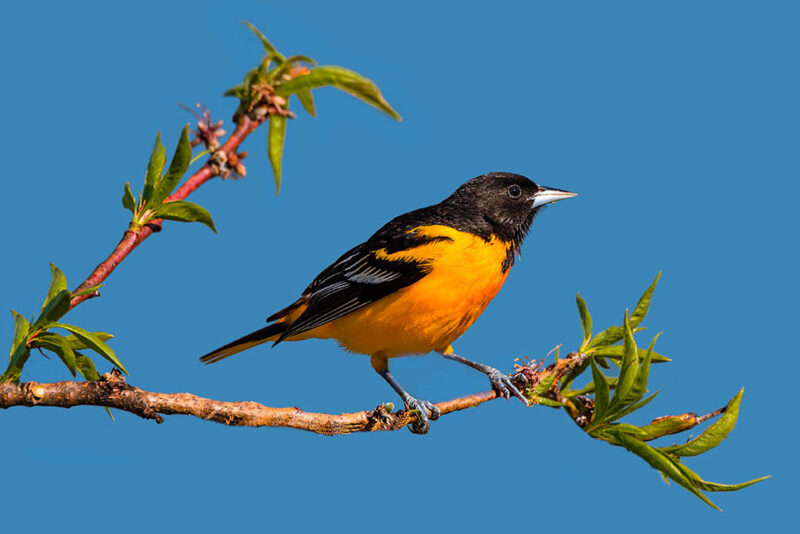
Are you searching for helpful information about the different types of blackbirds? You’ll find 25 of them in North America, and 13 blackbird species reside full or part-time in Iowa. What’s interesting about blackbirds is that, while they are partly black, many are also brilliantly colored and very attractive.
Unfortunately, several species of blackbirds in Iowa are also considered agricultural pests. They gather in massive flocks that can decimate fields, and they consume massive amounts of grains and seeds. When they do, they also make a tremendous amount of noise. Still, pest or not, blackbirds are fascinating birds, and in Iowa, you’re bound to spot some of the 13 types on today’s list. Read on to discover more about blackbirds and how to identify the different species found in Iowa!

The 13 Types of Blackbirds in Iowa
1. European Starling
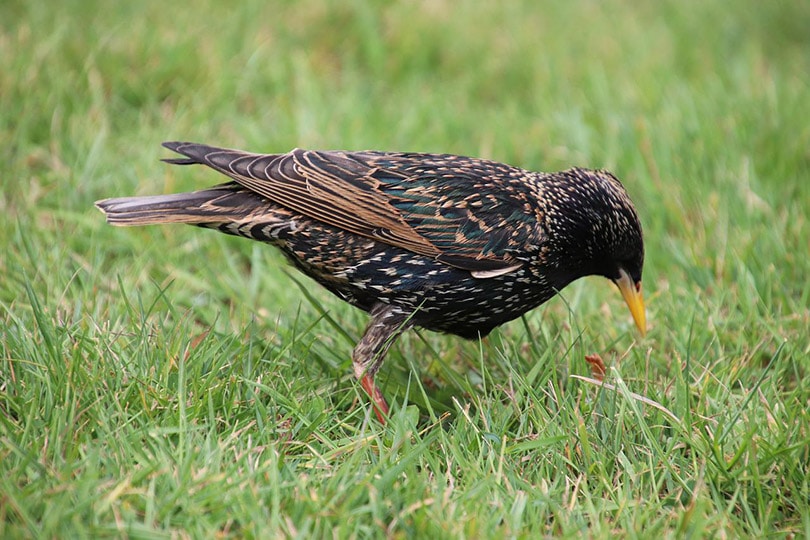
| Habitat: | Lowlands, urban, grassland |
| Food: | Insects |
| Nesting: | Cavity |
| Behavior: | Ground forager |
| Conservation: | Low Concern (LC) |
The European Starling arrived in North America in 1890 when 100 were brought over from Europe and released in New York City. The good news is that they thrived, multiplying at a prodigious rate. The bad news is that European Starlings are one of Iowa’s biggest pests, forming massive and aggressive flocks that chase away other birds and eat everything in sight.
They can live just about anywhere as long as there are large, open fields where they can forage, which Iowa has in abundance. European Starlings are colorful, gregarious birds with short tails, beautiful coloring in summer, and white spots on their black bellies in winter.
2. Common Grackle
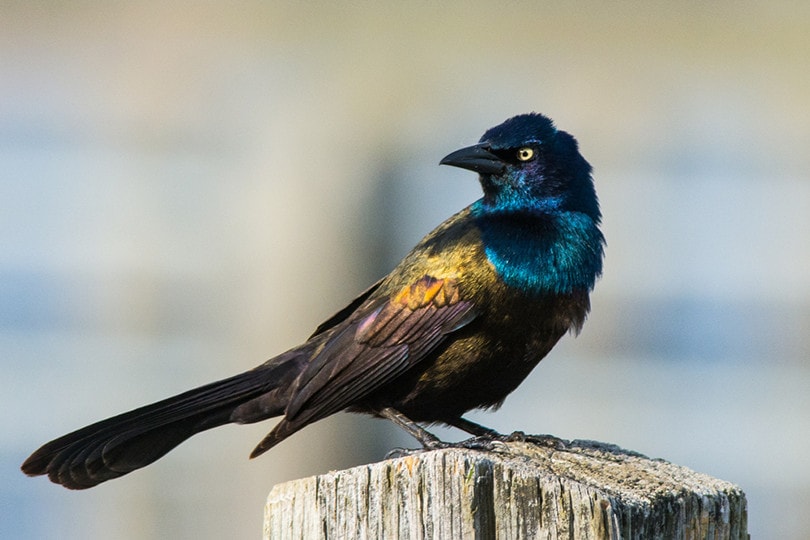
| Habitat: | Open woodlands |
| Food: | Omnivore |
| Nesting: | Trees |
| Behavior: | Ground forager |
| Conservation: | Steep Decline (SD) |
The Common Grackle is a gorgeous blackbird with a deep blue head, purplish body, and long tail. They have a powerful thick black beak and white eyes that stand out against their deep blue head. Some say Common Grackles look like a blackbird stretched out since their tail is so long.
As omnivores, the Common Grackles eat practically anything but have a penchant for corn, making them a pest in Iowa. Indeed, they’re the #1 threat to corn crops in Iowa. Common Grackles gladly mix it up with other bird species to form large flocks, and their long bodies make them easy to spot. One fascinating fact about Common Grackles is that they engage in a practice called “anting.” That’s where they let ants cover their body so that the formic acid they secrete kills parasites on their feathers.
3. Orchard Oriole
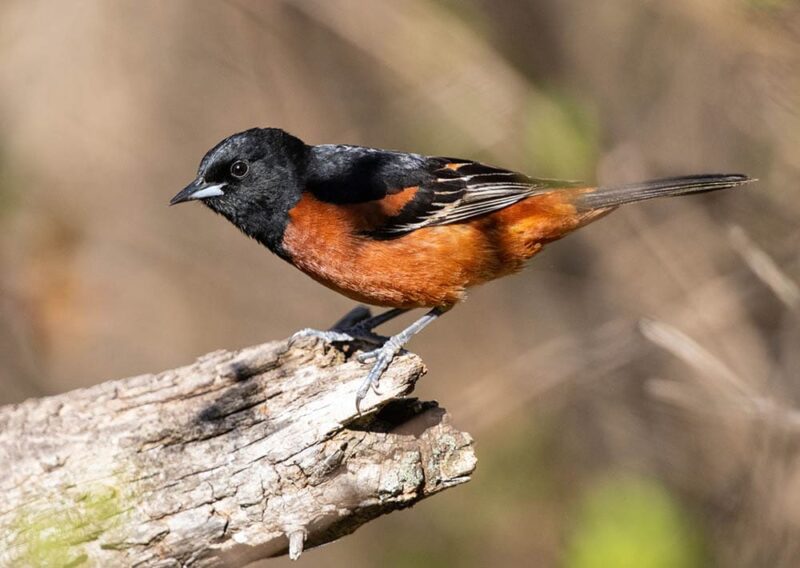
| Habitat: | Open Woodlands |
| Food: | Insects, seeds |
| Nesting: | Tree, cavity |
| Behavior: | Foliage gleaner |
| Conservation: | Low concern (LC) |
In Iowa, you’ll find Orchard Orioles in open woodlands, farms, shrub land, and along the shores of lakes. However, the blackbirds are hard to spot because they spend most of their days on the very tops of large trees. Also, while other blackbird species in Iowa will gladly come to your bird feeder, Orchard Orioles are notoriously hard to attract.
Male and female Orchard Orioles exhibit high sexual dimorphism, which means they look very different. Males have bright orange bodies with jet-black heads and tails. Females are orange and yellow over their entire bodies with tan wings. Orchard Orioles will come to a hummingbird feeder on occasion. During their breeding season, they are monogamous but find a new mate each season. Although they are classified as a low concern (LC) species, the Orchard Oriole population is declining.
4. Red Winged Blackbird
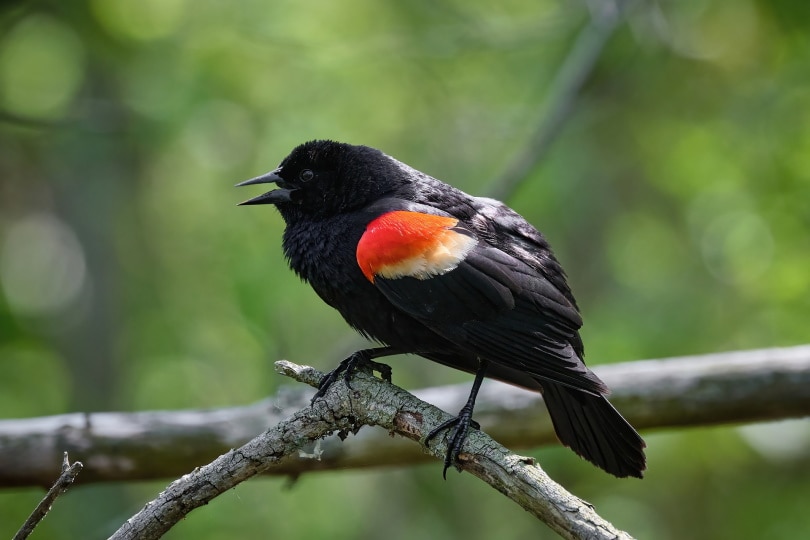
| Habitat: | Marshes |
| Food: | Insects |
| Nesting: | Shrub |
| Behavior: | Ground forager |
| Conservation: | Low concern (LC) |
You’ll find Red Winged Blackbirds all over Iowa since they’re one of the most common blackbirds in North America. The best place to spot them is along marshes and wet forest areas, where they like to sit on cattails and telephone wires. Red Winged Blackbirds exhibit extreme sexual dimorphism, and the females look nothing like their male counterparts.
Females are mostly brown and tan, with some pale orange on their heads. Males are almost all black with a large splotch of bright orange and yellow at the top of their flight feathers. The best place to find Red Winged Blackbirds during mating season is near marshes and wet areas where they tend to build their nests. Males are very aggressive towards other animals during this time and are known to attack anything that gets close. (So be careful!)
5. Brown-headed Cowbird
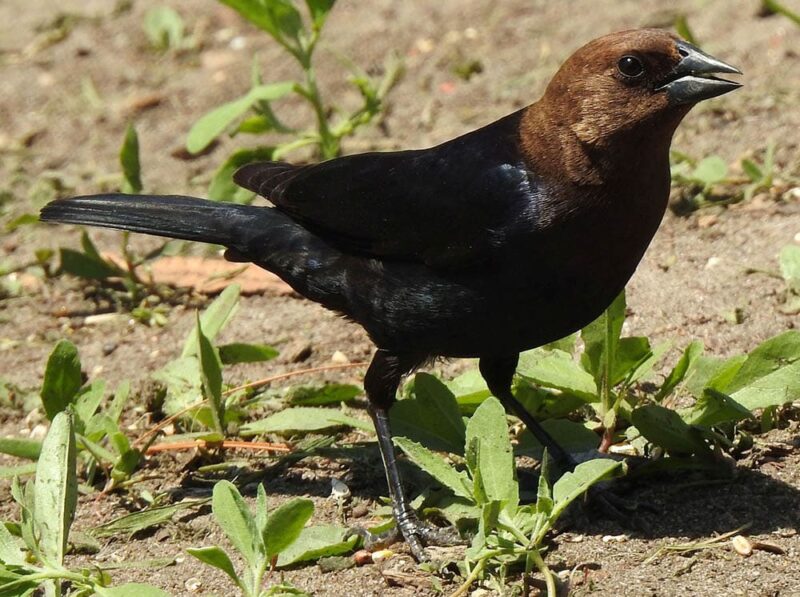
| Habitat: | Grasslands |
| Food: | Seeds |
| Nesting: | Trees (Brood parasite) |
| Behavior: | Ground forager |
| Conservation: | Low concern (LC) |
One of the most fascinating of all the blackbirds that call Iowa home is the Brown-headed Cowbird. There are two reasons why this is so. First, they are large, black birds with dark brown heads, which makes them easy to spot. Second is that, rather than making their own nest, Brown-headed Cowbird females lay their eggs in the nests of other birds and let the birds raise their young.
This behavior is known as “brood parasiting” and seems to work exceedingly well as Brown-headed Cowbirds have a massive population in Iowa and North America. They are also polygynous, which means they have different mates, sometimes during the same season. Brown-headed Cowbirds, not surprisingly, get along famously with other birds when it’s not mating season and form large mixed-species flocks. Unfortunately, as their nest-stealing ways kill other species, the Brown-headed Cowbird is considered a nuisance in Iowa.
6. Baltimore Oriole
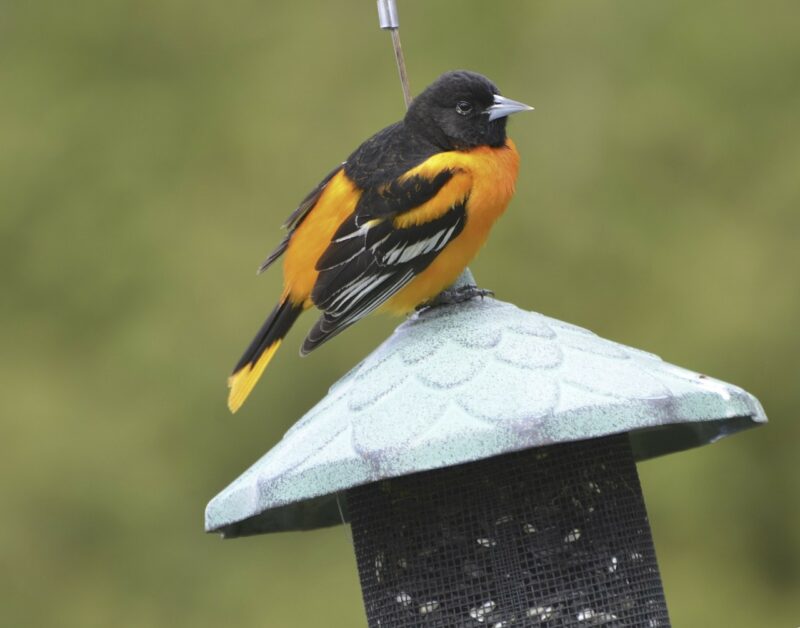
| Habitat: | Forests |
| Food: | Insects, seeds |
| Nesting: | Tree |
| Behavior: | Foliage gleaner |
| Conservation: | Low concern (LC) |
One of the easiest ways to detect a Baltimore Oriole in Iowa is to listen for their deep song, which sounds like someone whistling a tune. Of course, the best way is to spot their magnificent, bright-orange feathers covering most of their lower body and tail. Up top, the Baltimore Orioles’ head is jet-black, with black eyes that disappear into the blackness.
The Baltimore Oriole female is an amazing nest builder who makes a hanging nest high in trees, where both males and females like to spend their days. The good news is that Baltimore Orioles will gladly come to your bird feeder and backyard if you have plants and trees with bright fruit, especially raspberries, mulberries, and cherries. Baltimore Oriole chicks have to wait at least a year to get their gorgeous coloring, and, amazingly, with every molt, they get even brighter.
7. Brewer’s Blackbird
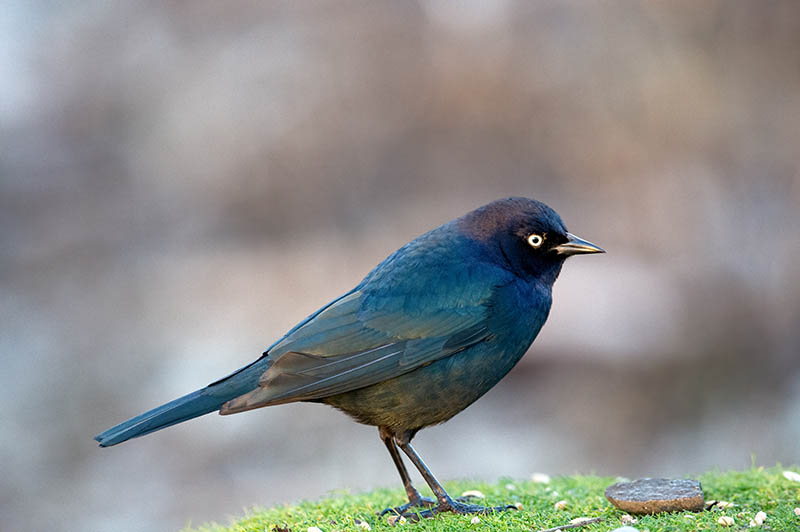
| Habitat: | Urban and suburban |
| Food: | Seeds |
| Nesting: | Shrubs |
| Behavior: | Ground forager |
| Conservation: | Steep decline (SD) |
Seeing the Brewer’s Blackbird in full sunshine is a must because, when you do, the brilliance of their feathers shines through. Although they might look black, in full sun, the Brewer’s Blackbird color changes to a combination of midnight blue, dark purple, and hints of emerald green. In short, they’re spectacular when seen in the right light. Even better, you can see them easily in Iowa as Brewer’s Blackbirds love urban and suburban areas, especially parks, golf courses, and open fields.
Spotting them is easy since they aren’t shy and spend a lot of time on the ground foraging for seeds and the occasional insect. The species exhibits moderate to extreme sexual dimorphism as the female is a dark brown color and tan color.
8. Bullock’s Oriole

| Habitat: | Open woodlands |
| Food: | Insects, fruits |
| Nesting: | Tree |
| Behavior: | Foliage gleaner |
| Conservation: | Low concern (LC) |
It’s relatively easy to spot the Bullock’s Oriole in Iowa as they have bright orange bodies with black and white flight feathers. Many birdwatchers who like this lovely blackbird species attract them to their yards with small fruits, including orange slices. The Bullock’s Oriole hangs upside-down when foraging in trees, on bird feeders, and when weaving their unbelievable nests.
The Bullock’s Oriole species exhibit moderate sexual dimorphism. Males, as is typical, are more brightly colored than females, with gray bodies and pale, yellow heads. Bullock’s Orioles are known to come to hummingbird feeders for the sugar water, chasing away the smaller birds in the process. Both the males and females sing, but the female Bullock’s Orioles song is considered more melodic, and they tend to sing much more than males.
9. Hooded Oriole
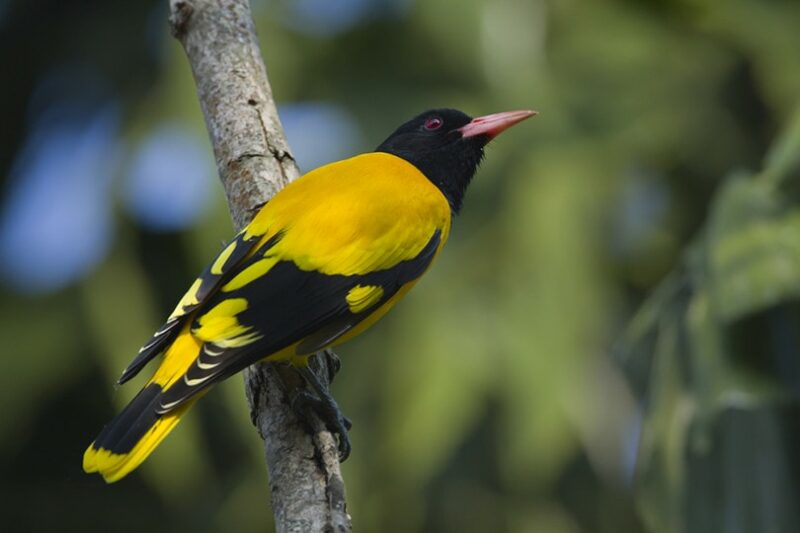
| Habitat: | Open woodlands |
| Food: | Insects, fruits |
| Nesting: | Trees |
| Behavior: | Foliage gleaner |
| Conservation: | Low concern (LC) |
Another gorgeous blackbird you’ll find in Iowa is the Hooded Oriole, especially when they’re flying. Hooded Orioles are very noisy birds, making it relatively easy to locate them when birdwatching. Spotting them, however, is a different story since they like to stay hidden in trees. Hooded Orioles move very slowly compared to most smaller birds, especially when foraging for food. Like the Bullock’s Oriole, they also prefer hummingbird feeders and will hang upside-down to get to the sugar water. Males and females look similar, but the orange plumage on the male is quite a bit brighter than the female.
One way to differentiate them from other blackbirds is the Hooded Oriole’s slightly curved bill, which helps them dig out insects. Although they migrate south from Iowa in winter, some Hooded Orioles will stick around, especially if you give them the food, water, and shelter they need.
10. Rusty Blackbird
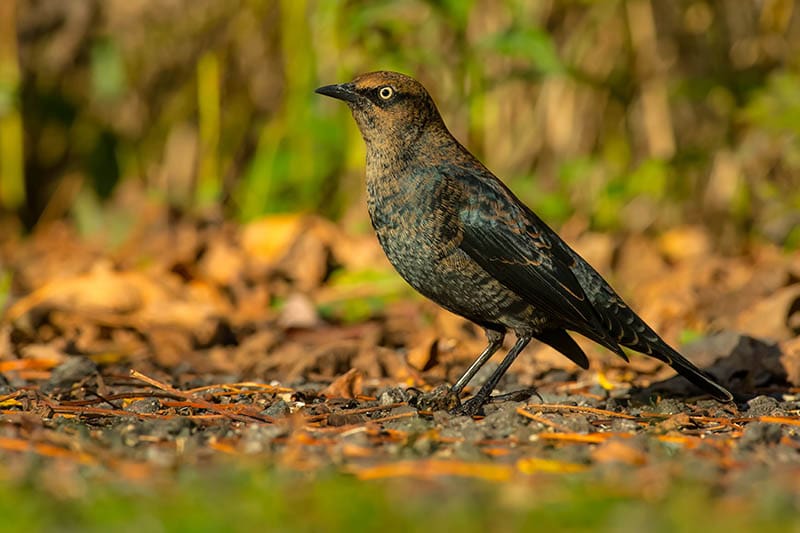
| Habitat: | Wet forests |
| Food: | Insects |
| Nesting: | Trees |
| Behavior: | Ground forager |
| Conservation: | Steep decline (SD) |
Although spotting them isn’t too difficult, the Rusty Blackbird is unfortunately in steep decline in North America. Even worse is that conservationists don’t know the cause of the decline, although human encroachment, pollution, and other factors are surely to blame. The Rusty Blackbird is an attractive color and, much like its name, looks rusty on top thanks to dark blue feathers with dark brown splotches. Females are more of a light brown color.
Breeding males are often entirely black, making it difficult to identify them. An interesting and disturbing fact about the Rusty Blackbird is that it will sometimes attack and eat other birds. Rusty Blackbird males sing a lot when trying to attract a mate and travel in small flocks. One reason they may be on the decline is the loss of wetland areas in Iowa.
11. Hooded Oriole

| Habitat: | Open woodlands |
| Food: | Insects |
| Nesting: | Trees |
| Behavior: | Foliage gleaner |
| Conservation: | Low concern (LC) |
The Hooded Oriole, at least when further south of Iowa, is known as the “Palm-Leaf Oriole” because they tend to build their nests in, you guessed it, palm trees. The female Hooded Oriole is an amazing nest builder or, technically, nest sewer, as she uses fibers to sew a nest in large leaves.
Like several of the blackbirds on today’s list, the Hooded Oriole loves to steal sugar water from hummingbird feeders. Male and female Hooded Orioles are similar in color, but, as with many bird species, the males are much brighter than the females. Bright they are, too, with a beautiful, dark orange head and body and black flight feathers with white streaks. Although most Hooded Orioles will migrate to Mexico in winter, some will stick around your Iowa backyard if you give them food and water.
12. Eastern Meadowlark

| Habitat: | Grasslands |
| Food: | Insects |
| Nesting: | Ground |
| Behavior: | Ground forager |
| Conservation: | Steep decline (SD) |
This strikingly beautiful blackbird sadly is in steep decline in Iowa and the rest of North America. The loss of habitat is one cause, as well as poisoning from insecticides and other agricultural chemicals. On a lighter and more musical note, the Eastern Meadowlark has been recorded as having over 100 song patterns, which is an incredibly large number for any species.
They sing towards the end of the day (mostly), and their song has been compared to the sound of a flute. While not as striking as some, the Eastern Meadowlark has a gorgeous, bright yellow belly with tan and white flight feathers. It also has a splash of black on its upper chest in the shape of a ‘V’ and very long legs, which sets it apart from the other blackbirds.
13. Bobolink

| Habitat: | Grasslands |
| Food: | Seeds |
| Nesting: | Ground |
| Behavior: | Ground forager |
| Conservation: | Declining (D) |
The last blackbird on our list is the Bobolink, which breeds in Iowa. The male Bobolink can be seen frantically flying for a mate and singing. Their song has been called “helicopter-like,” which is a good way to describe it. Bobolinks travel huge distances when they migrate, unlike most blackbirds.
They also have an olfactory nerve and bulb (the “smell” nerve) that allows them to orient themselves with the Earth’s magnetic field, which is helpful when traveling over 12,000 miles! Another interesting fact is that Bobolinks molt two times a year, not one, and have different feathers during the breeding season. Loss of habitat and agricultural chemicals are primarily at fault for this amazing bird’s steeply declining numbers.

Conclusion
The Hawkeye State, Iowa, is one of the world’s largest food producers known for its vast, rolling plains and acres of corn. Although its state bird is the Eastern Goldfinch, as we’ve seen today, 13 species of blackbird call Iowa home for at least part of the year. Many of these blackbird species are truly gorgeous, with amazing colors and color combinations, beautiful songs, and excellent skills.
Most of the birds are prolific enough that spotting them shouldn’t be a problem, although some are good at hiding and others are in decline, making it more difficult. In any case, best of luck when you’re birdwatching in Iowa! With everything you’ve learned today, spotting many of these magnificent birds will be much easier.
Check out more black birds here:
- 11 Types of Black Birds in Utah
- 15 Types of Blackbirds in Kentucky
- 12 Types of Black Birds in Delaware
Featured Image Credit: Jay Gao, Shutterstock
Table of Contents
About the Author Greg Iacono
Greg Iacono is a self-taught writer and former chiropractor who, ironically, retired early due to back problems. He now spends his time writing scintillating content on a wide variety of subjects. Greg is also a well-known video script writer known for his ability to take a complex subject and make it accessible for the layperson.
Related Articles:
Monocular vs Telescope: Differences Explained (With Pictures)
10 Types of Hummingbirds in Arkansas (With Pictures)
8 Types of Hummingbirds in Nebraska (With Pictures)
5 Types of Hummingbirds in Idaho (With Pictures)
3 Types of Hummingbirds in Mississippi (With Pictures)
8 Types of Hummingbirds in Kansas (With Pictures)
5 Types of Hummingbirds in West Virginia (With Pictures)
5 Types of Hummingbirds in Ohio (With Pictures)
